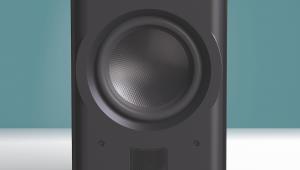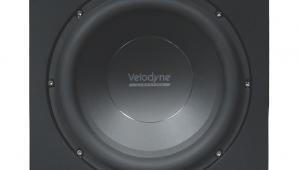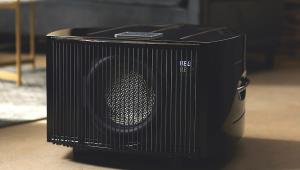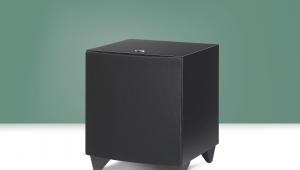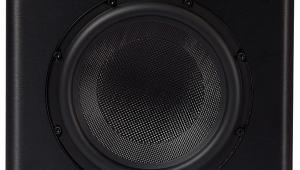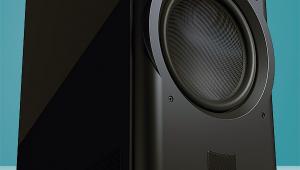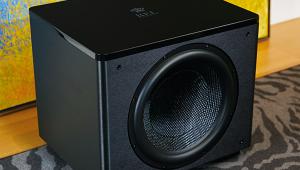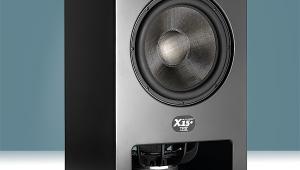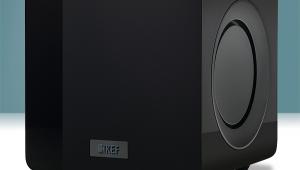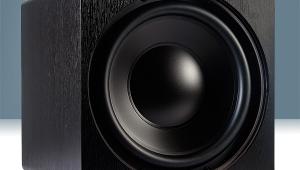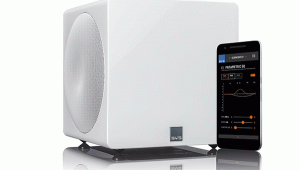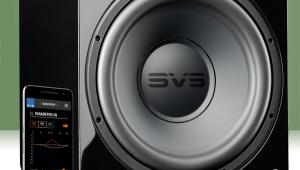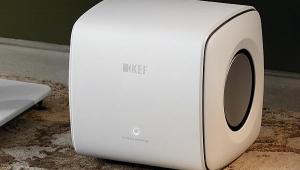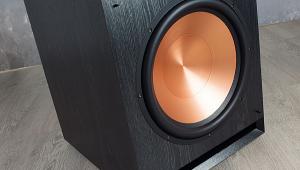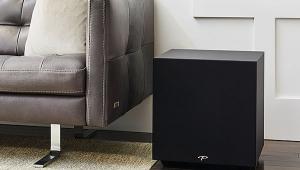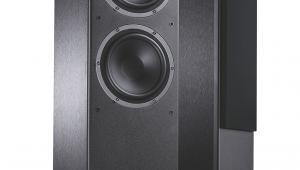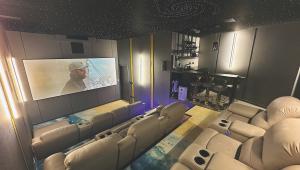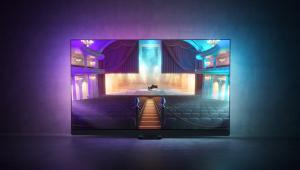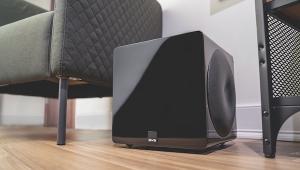REL No.25 premium subwoofer review
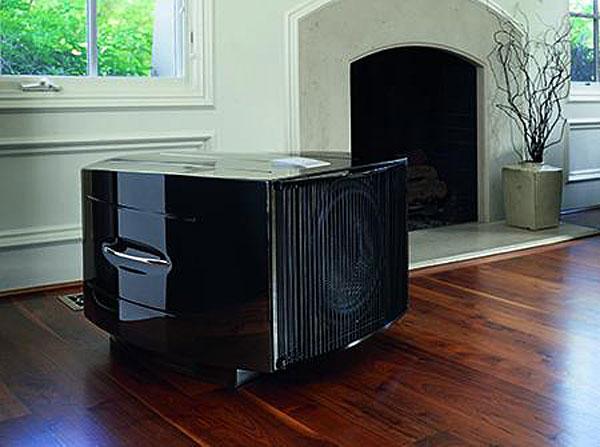
 Commemorating 25 years of REL sub-bass systems in some style, the company's No.25 is a very special subwoofer and mad as a box of frogs. A really, really big box of frogs, too. Weighing in at a whopping 76kg, its width is close to 75cm, it's over 80cm deep including connectors poking out and it stands 54cm tall. And even if you have a large room to house it, you'll need a big wallet as well. The price? A cool £6,500.
Commemorating 25 years of REL sub-bass systems in some style, the company's No.25 is a very special subwoofer and mad as a box of frogs. A really, really big box of frogs, too. Weighing in at a whopping 76kg, its width is close to 75cm, it's over 80cm deep including connectors poking out and it stands 54cm tall. And even if you have a large room to house it, you'll need a big wallet as well. The price? A cool £6,500.
REL could have probably gone taller with its cabinet design to give the No.25's 15in carbon cone bass driver some more breathing space, had it not been for the REL Reference Line Array concept. That is two sets of three No.25s (so six in total) stacked on top of each other in a stereo pair. Sadly, Reference Line Arrays are only available to responsible adults, so the company only gave me one No.25 to play with.
REL’s irrepressible owner, John Hunter, came supplied with our No.25 to give it a proper introduction. John took over the brand a few years ago from the equally passionate and equally slightly eccentric Richard Lord. Like some of Richard’s flagship designs, such as the epic REL Studio, there really is nothing else quite like the No.25, and this beast of a sub-bass system is John’s own subwoofing magnum opus. It's a back-to-the-drawing-board design built upon two years of R&D and a development budget that must have had the brand’s accountants twitching nervously. They might be happier now, though, as I'm told the No.25 has been getting more orders internationally in Reference Line Array configuration than as a single sub.
Aiming for accuracyAt its heart is the desire to make the No.25 the world’s best sub-bass system. Not necessarily the loudest or the fattest or the deepest, but the most accurate and realistic.
The No.25, Hunter explains, is designed to produce bass as fast and as precise as possible, to best replicate real-life low-frequency sounds in music and movies. 'Getting the frequency at high SPL is easy,' says the REL man. 'We also wanted to deliver the critical first transient and the subtle decay pattern at the back end of each sound. It had to be very fast. To replicate a gunshot you need to gain +20dB instantly.'
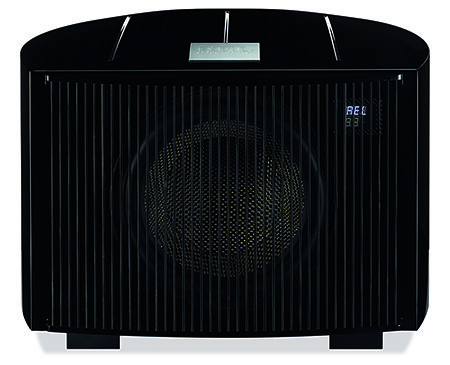
That is tricky to achieve with a traditional large, heavy driver as you have to overcome the cone’s inertia – both accelerating the weight forward and then changing direction and pulling it back. ‘You cannae change the laws of physics, Captain,’ as any Trekker will tell you. REL's idea was to circumnavigate them instead by creating one of the world’s lightest 15in bass cones, crafted from woven carbon fibre and layered to create a stiff, uniform and balanced structure. And the voice coil is much smaller and lighter than those typically found in large subwoofer designs, with REL developing a new coil winding process to allow an incredibly small gap between coil and magnet. The result is a 15in driver with a 4in throw and a cone that weighs less than those found in the company’s 10in drivers of just two years ago.
Hunter and his team say they could not find a suitable Class D amp with the required speed, accuracy and high-current ability for the No.25’s driver. So REL partnered with an electronics manufacturer to design one for the task. The final outcome is a bespoke 1,000W (RMS) amp with an ultra-high-current power supply.
The filter network was next up for attention. REL’s crossovers and ability to hookup a sub to the speaker terminals of a main stereo amplifier are well known, so this was simply a case of cherry-picking the very best components for the new flagship. To the filter network the engineers added a parametric EQ system. This is capable of adjusting two frequencies of your choice by +/- 6dB in 1/3rd octave increments. Yet there's no automation or measurement system, so this is sound-tuning of the old school – by ear.
And then there is the cabinet. While my own Velodyne DD18+ has looks to scare small children, the No.25 simply eats them whole. Its cord-fronted grille brings to mind jail bars restraining the driver and white LED display, while the sumptuous 12-layer gloss black lacquer and chunky aluminium REL logo on top shout high-end design.
Yet the cabinet’s real magic is below the surface. Traditional methods of bending MDF into a curve include steaming the board and scoring the surface. Both of these processes undermine the integrity of the fibre bonds and, says REL, create a softer-sounding enclosure.
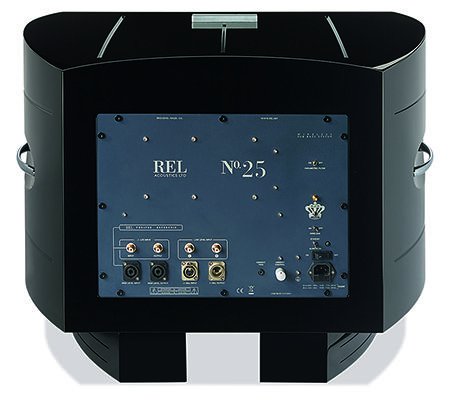
So the No.25 cabinet is made from high-quality 30mm MDF (sourced from Australia) and bombarded with RF energy for three hours. This temporarily softens the bonds, allowing it to be shaped into the No.25’s reflection-cancelling curves. As the material cools, the bonds regain their integrity. The panels are then braced with hardwood spars, positioned to break up some common mode resonances as well as provide further stiffening. The finishing interior touch is the type of wadding used inside the cabinet, a fibrous cotton material that's also employed for high-end building insulation and, er, denim jeans.
The No.25 package is finished off with a high- and low-level connection suite (REL suggests running both simultaneously), subtle down-firing LEDs to give it a floaty look and a truly bonkers remote control. More objet d’art than typical plastic stick, you are only likely to use the remote for setup and then never again. Makes a cracking high-end paper weight, though.
Glossing over the box the size of a transit van and the physical requirement of hefting the beast into place, Hunter arrived a couple of days later to do the setup. This is the same REL-approved setup procedure as No.25 buyers can expect from their approved retailer, so there are no special privileges here. Two hours of playing tones and tunes, adjusting placement of the sub and main speakers, and tweaking the subtle parametric EQ, and the job was done.
The unit caters for wireless transmission via REL's optional LongBow system, but this wasn't used.
Underwater AVStarting with a classic, I went straight for submarine high-tension thriller U-571 (Blu-ray). If I had a pound for every time I have heard the depth charge scene I could probably afford a No.25, but I have never heard the explosions portrayed anything like how they emerged from this woofer. Here, they are dynamically explosive rather than just a huge room-filling boom. It’s so much more realistic, and I speak with some authority having been scuba diving when Indonesian locals decided to go fishing nearby with dynamite.
By a country mile the No.25 produces the fastest, tightest bass I have ever heard in my cinema room. This might not be what you would expect from such a sizable driver – we tend to think of smaller woofers having the edge in terms of speed. Yet each percussive event is so eye-wateringly taut it has sharp edges.
There is plenty of power and weight, of course, but if the Velodyne DD18+ has sledgehammer bass then the No.25 is a log-splitting maul; same depth and grunt just with more cutting-edge attack.
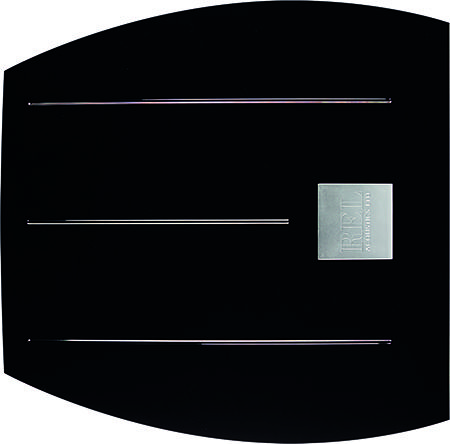
A re-watching of John Wick (Blu-ray) further underpins the REL’s abilities for realism. Gunshots in the underground night club have astonishing, tangible impact, while the crunch of car-crashes seems all the more wince-worthy and extreme. It’s a sensation that you feel as much as hear and not just in a gizzard-churning high-SPL sort of way. The REL No.25 is all about creating a credible, believable low-frequency experience at any level.
This effect is highlighted on Deadpool (Blu-ray) when our lead character turns and talks directly to the audience. The dialogue is engineered with a subtle shift in timbre that pulls the voice out of the open scene and into a more confined space with you. The REL helps my speaker surround sound system properly nail the technique. The conversation snaps seamlessly away from ambience and action of the movie, into your room and back out again, and it's really obvious. Turn off the sub and you are hard-pressed to hear the effect, let alone experience what the director and sound team intended.
If you are keen on listening to music through your cinema array, the REL performs admirably in this regard, too. While integrating a subwoofer into a two-channel system can be tricky, the No.25’s filter network makes it simple and the effect is sublime. A fulsome bass output enhances the entire frequency spectrum of music, not just the LF, and the No.25 is no exception. It adds body, warmth and plenty of that greater sense of realism to even female vocal pieces, while managing to further open up the imaging and soundstage.
Birdy’s eponymous first album (CD) was subtly enhanced and sounded bigger and more spacious with the No.25 dialled in, its high-level connection attached to my amp’s speaker terminals. Stick on the likes of house maestro Deadmau5 and you wont be disappointed either… although I was struggling to keep plates on the shelves in the adjacent kitchen.
A minor whineI only really have one negative comment about the No.25, beyond the typical 'it's big and it's heavy,' and that's that the front-facing LED display causes a faint whine through the driver. Apparently the company wanted white LEDs rather than a more garish blue, and this is an unavoidable side-effect of the display unit specified. The display only comes on when an adjustment is being made and switches off after a few seconds, so it’s not a big issue but it is a bit ‘odd’ at this price.
Speaking of price by way of conclusion, I am frankly stunned the No.25 doesn’t actually cost more. If I'd been told that it was going to retail at £10,000 given all the R&D that has gone into it, the size, the finish and the outstanding performance, I would have still thought that represented good value. As it is, £6,500 gets you one of the very best residential subwoofers you can buy at any price.
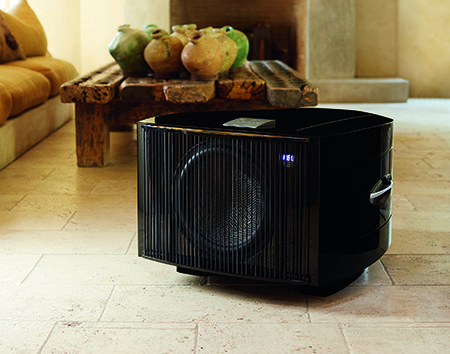
Specification
Drive units: 1 x 15in woven carbon fibre driver with 4in throw Enclosure: (Massive) sealed cabinet Frequency response (claimed): Down to 14Hz (-6dB) On board power: 1,000W RMS Remote control: Yes. Bespoke item
Dimensions: 737(w) x 540(h) x 762(d)mm Weight: 76kg
Connections: High-level (Neutrik Speakon) stereo input; low-level stereo phono input; LFE input; LFE XLR input; high-level stereo output; LFE output; LFE XLR output; SMA for wireless antenna (optional LongBow system)
 |
Home Cinema Choice #351 is on sale now, featuring: Samsung S95D flagship OLED TV; Ascendo loudspeakers; Pioneer VSA-LX805 AV receiver; UST projector roundup; 2024’s summer movies; Conan 4K; and more
|


